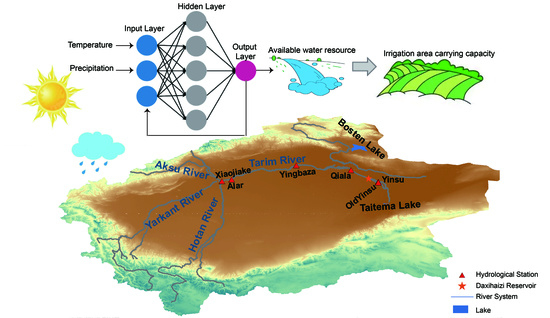Prediction of the Irrigation Area Carrying Capacity in the Tarim River Basin under Climate Change
Abstract
:1. Introduction
2. Materials and Methods
2.1. Study Site and Data Sources
2.2. Method
2.2.1. Analysis of Irrigation Area Carrying Capacity
2.2.2. Nonlinear Autoregressive with Exogenous Input (NARX) Neural Network
3. Results
3.1. Changes in Land Use and Irrigation Areas
3.2. Model Training and Validation
3.3. Prediction of Irrigation Area under Climate Change
4. Discussion
5. Conclusions
Author Contributions
Funding
Institutional Review Board Statement
Informed Consent Statement
Data Availability Statement
Conflicts of Interest
References
- Gaur, M.; Squires, V. Geographic Extent and Characteristics of the World’s Arid Zones and Their Peoples. In Climate Variability Impacts on Land Use and Livelihoods in Drylands; Springer: Cham, Switzerland, 2018. [Google Scholar]
- Golla, B. Agricultural production system in arid and semi-arid regions. J. Agric. Sci. Food Technol. 2021, 7, 234–244. [Google Scholar]
- Mekuria, W. The link between agricultural production and population dynamics in Ethiopia: A review. Adv. Plants Agric. Res. 2018, 8, 348–353. [Google Scholar] [CrossRef]
- Tao, H.; Gemmer, M.; Song, Y.; Jiang, T. Ecohydrological responses on water diversion in the lower reaches of the Tarim River, China. Water Resour. Res. 2008, 44, W08422. [Google Scholar] [CrossRef]
- Liu, Q.; Dai, H.; Gui, D.W.; Hu, B.; Ye, M.; Wei, G.; Qin, J.; Zhang, J. Evaluation and optimization of the water diversion system of ecohydrological restoration megaproject of Tarim River, China, through wavelet analysis and a neural network. J. Hydrol. 2022, 608, 127586. [Google Scholar] [CrossRef]
- Fang, G.; Chen, Y.; Li, Z. Variation in agricultural water demand and its attributions in the arid Tarim River Basin. J. Agric. Sci. 2018, 156, 301–311. [Google Scholar] [CrossRef]
- Hao, Z.; Chen, S.; Li, Z.; Yu, Z.; Shao, Q.; Yuan, F.; Shi, F. Quantitative assessment of the impacts of irrigation on surface water fluxes in the Tarim River, China. Hydrol. Res. 2015, 46, 996–1007. [Google Scholar] [CrossRef]
- Duethmann, D.; Bolch, T.; Farinotti, D.; Kriegel, D.; Vorogushyn, S.; Merz, B.; Pieczonka, T.; Jiang, T.; Su, B.; Guntner, A. Attribution of streamflow trends in snow and glacier melt-dominated catchments of the Tarim River, Central Asia. Water Resour. Res. 2015, 51, 4727–4750. [Google Scholar] [CrossRef] [Green Version]
- Liu, S. The contemporary glaciers in China based on the Second Chinese Glacier Inventory. Acta Geogr. Sin. 2015, 70, 3–16. [Google Scholar]
- Guo, W.; Xu, J.; Liu, S.; Shangguan, D.; Wu, L.; Yao, X.; Zhao, J.; Liu, Q.; Jiang, Z.; Li, P.; et al. The Second Glacier Inventory Dataset of China (Version 1.0). Cold Arid Reg. Sci. Data Cent. Lanzhou 2014. [Google Scholar] [CrossRef]
- Huang, M.; Wortmann, D.; Duethmann, C.; Menz, F.Z.; Shi, C.Y.; Krysanova, V. Adaptation strategies of agriculture and water management to climate change in the Upper Tarim River basin, NW China. Agric. Water Manag. 2018, 203, 207–224. [Google Scholar] [CrossRef]
- Wang, F.; Chen, Y.; Li, Z.; Fang, G.; Li, Y.; Xia, Z. Assessment of the Irrigation Water Requirement and Water Supply Risk in the Tarim River Basin, Northwest China. Sustainability 2019, 11, 4941. [Google Scholar] [CrossRef] [Green Version]
- Li, Y.; Wang, H.; Chen, Y.; Deng, M.; Li, Q.; Wufu, A.; Wang, D.; Ma, L. Estimation of regional irrigation water requirements and water balance in Xinjiang, China during 1995–2017. PeerJ 2020, 8, e8243. [Google Scholar] [CrossRef] [PubMed] [Green Version]
- Yu, Y.; Disse, M.; Yu, R.; Yu, G.; Sun, L.; Huttner, P.; Rumbaur, C. Large-scale hydrological modeling and decision-making for agricultural water consumption and allocation in the main stem Tarim River, China. Water 2015, 7, 2821. [Google Scholar] [CrossRef] [Green Version]
- Wei, G.; Gui, D.; Zhao, X. Irrigation area carrying capacity in Tarim River Basin in different years. Arid Land Geogr. 2018, 41, 230–237. [Google Scholar]
- Guo, H.; Xu, H.; Zhao, X. Discussion on the maximum irrigation area and overload situation in Tarim River Basin. J. Sun Yat-Sen Univ. (Nat. Sci. Ed.) 2017, 56, 140–150. [Google Scholar]
- Zhang, P.; Chen, C.; Xu, H. The bearable largest irrigation area in the basins of nine source streams and ma- instream of the Tarim River. Arid Zone Res. 2017, 34, 223–231. [Google Scholar]
- Duethmann, D.; Menz, C.; Jiang, T.; Vorogushyn, S. Projections for headwater catchments of the Tarim River reveal glacier retreat and decreasing surface water availability but uncertainties are large. Environ. Res. Lett. 2016, 11, 054024. [Google Scholar] [CrossRef] [Green Version]
- Liu, Z.F.; Xu, Z.X.; Fu, G.B.; Yao, Z.J. Assessing the hydrological impacts of climate change in the headwater catchment of the Tarim River basin, China. Hydrol. Res. 2013, 44, 834–849. [Google Scholar] [CrossRef]
- Yang, P.; Xia, J.; Zhang, Y.Y.; Zhan, C.S.; Sun, S.X. How is the risk of hydrological drought in the Tarim River Basin, Northwest China? Sci. Total Environ. 2019, 693, 133555. [Google Scholar] [CrossRef]
- Hao, X.M.; Li, W.D.; Huang, X.; Zhu, C.G.; Ma, J.X. Assessment of the groundwater threshold of desert riparian forest vegetation along the middle and lower reaches of the Tarim River, China. Hydrol. Processes 2010, 24, 178–186. [Google Scholar] [CrossRef]
- Liu, J. Remote sensing monitoring dataset of land use status in six provinces in western China for many years (1970s, 1980s, 1995, 2000, 2005, 2010, 2015). Natl. Tibet. Plateau Data Cent. 2019. [CrossRef]
- Gou, S.; Zhang, X.; Wang, Y.; Gong, W.; Wang, Y.; Deng, M.; Mao, W.; Wang, S. Analysis on runoff volumes, water quality and water consumption of the Tarim River in recent 50 years. Arid Zone Res. 2010, 27, 861–870. [Google Scholar]
- O’Neill, B.C.; Tebaldi, C.; van Vuuren, D.P.; Eyring, V.; Friedlingstein, P.; Hurtt, G.; Knutti, R.; Kriegler, E.; Lamarque, J.F.; Lowe, J.; et al. The Scenario Model Intercomparison Project (ScenarioMIP) for CMIP6. Geosci. Model Dev. 2016, 9, 3461–3482. [Google Scholar] [CrossRef] [Green Version]
- Thrasher, B.; Wang, W.; Michaelis, A.; Nemani, R. NEX-GDDP-CMIP6. NASA Center for Climate Simulation. 2021. Available online: https://www.nccs.nasa.gov/services/data-collections/land-based-products/nex-gddp-cmip6 (accessed on 12 December 2021).
- Szidarovszky, F.; Coppola, E.; Long, J.; Hall, A.; Poulton, M. A hybrid artifcial neural network-numerical model for groundwater problems. Groundwater 2007, 45, 590–600. [Google Scholar] [CrossRef] [PubMed]
- LeCun, Y.; Bengio, Y.; Hinton, G. Deep Learning. Nature 2015, 521, 436–444. [Google Scholar] [CrossRef] [PubMed]
- Lin, T.; Horne, B.G.; Tino, P.; Giles, C.L. Learning long-term dependencies in NARX recurrent neural networks. IEEE Trans. Neural Netw. Learn. Syst. 1996, 7, 1424–1438. [Google Scholar]
- Guzman, S.M.; Paz, J.O.; Tagert, M.L.M. The Use of NARX Neural Networks to Forecast Daily Groundwater Levels. Water Resour Manag. 2017, 31, 1591–1603. [Google Scholar] [CrossRef]
- Chang, F.J.; Tsai, Y.H.; Chen, P.A.; Coynel, A.; Vachaud, G. Modeling water quality in an urban river using hydrological factors-data driven approaches. J. Environ. Manag. 2015, 151, 87–96. [Google Scholar] [CrossRef]
- Wunsch, A.; Liesch, T.; Broda, S. Groundwater level forecasting with artificial neural networks: A comparison of long short-term memory (LSTM), convolutional neural networks (CNNs), and non-linear autoregressive networks with exogenous input (NARX). Hydrol. Earth Syst. Sci. 2021, 25, 1671–1687. [Google Scholar] [CrossRef]
- Nash, J.E.; Sutcliffe, J.V. River Flow Forecasting through Conceptual Model. Part 1—A Discussion of Principles. J. Hydrol. 1970, 10, 282–290. [Google Scholar] [CrossRef]
- Yu, Y.; Yu, R.D.; Chen, X.; Yu, G.A.; Gan, M.; Disse, M. Agricultural water allocation strategies along the oasis of Tarim River in Northwest China. Agric. Water Manag. 2017, 187, 24–36. [Google Scholar] [CrossRef]
- Song, Y.D.; Fan, Z.L.; Lei, Z.D. Research on Water Resources and Ecology of Tarim River, China; Xinjiang People’s Press: Urumqi, China, 1999; pp. 398–418. (In Chinese) [Google Scholar]
- Qi, F.; Wei, L.; Jianhua, S. Environmental effects of water resource development and use in the Tarim River basin of northwestern China. Environ. Geol. 2005, 48, 202–210. [Google Scholar] [CrossRef]
- Zhao, R.; Chen, Y.; Shi, P. Land use and land cover change and driving mechanism in the arid inland river basin: A case study of Tarim River, Xinjiang, China. Environ. Earth Sci. 2013, 68, 591–604. [Google Scholar] [CrossRef]
- Ling, H.; Zhang, P.; Xu, H.; Zhang, G. Determining the ecological water allocation in a hyper-arid catchment with increasing competition for water resources. Glob. Planet. Chang. 2016, 145, 143–152. [Google Scholar] [CrossRef]
- Chen, C.; Pang, Y.M.; Pan, X.B. Variation characteristics of water requirement of cotton in China during 1961–2012. J. Nat. Resour. 2015, 30, 2108–2119. [Google Scholar]
- Zhao, J.; Wang, Z. Future trends of water resources and influences on agriculture in China. PLoS ONE 2020, 15, e0231671. [Google Scholar] [CrossRef]
- Thapa, S.; Zhao, Z.; Li, B.; Lu, L.; Fu, D.; Shi, X.; Tang, B.; Qi, H. Snowmelt-Driven Streamflow Prediction Using Machine Learning Techniques (LSTM, NARX, GPR, and SVR). Water 2020, 12, 1734. [Google Scholar] [CrossRef]
- Uysal, G.; Şensoy, A.; Şorman, A.A. Improving daily streamflowforecasts in mountainous upper euphrates basin by multi-layer per-ceptron model with satellite snow products. J. Hydrol. 2016, 543, 630–650. [Google Scholar] [CrossRef]
- Rasouli, K.; Hsieh, W.; Cannon, A. Daily streamflow forecasting by machine learning methods with weather and climate inputs. J. Hydrol. 2012, 414–415, 284–293. [Google Scholar] [CrossRef]
- Tao, H.; Gemmer, M.; Bai, Y.; Su, B.; Mao, W. Trends of streamflow in the Tarim river basin during the past 50 years: Human impact or climate change? J. Hydrol. 2011, 400, 1–9. [Google Scholar] [CrossRef]
- Chen, Y.N.; Takeuchi, K.; Xu, C.; Chen, Y.P.; Xu, Z.X. Regional climate change and its effects on river runoff in the Tarim Basin, China. Hydrol. Processes 2006, 20, 2207–2216. [Google Scholar] [CrossRef]
- Xu, Z.; Chen, Y.; Li, J. Impact of climate change on water resources in the Tarim River Basin. Water Resour. Manag. 2004, 18, 439–458. [Google Scholar] [CrossRef]
- Xu, C.C.; Chen, Y.; Li, W.H.; Chen, Y. Climate change and hydrologic process response in the Tarim River Basin over the past 50 years. Chin. Sci. Bull. 2006, 51, 25–36. [Google Scholar] [CrossRef]
- Shi, Y. Study on future runoff changes in Tarim River basin based on GCM model. Glob. Seabuckthorn Res. Dev. 2020, 5, 338. [Google Scholar]
- Xiang, Y.; Wang, Y.; Chen, Y.; Zhang, Q. Impact of Climate Change on the Hydrological Regime of the Yarkant River Basin, China: An Assessment Using Three SSP Scenarios of CMIP6 GCMs. Remote Sens. 2022, 14, 115. [Google Scholar] [CrossRef]
- Cheng, G.D.; Li, X.; Zhao, W.Z.; Xu, Z.M.; Feng, Q.; Xiao, S.C.; Xiao, H.L. Integrated study of the water–ecosystem–economy in the Heihe River Basin. Natl. Sci. Rev. 2014, 1, 413–428. [Google Scholar] [CrossRef] [Green Version]
- Chunyu, X.Z.; Huang, F.; Xia, Z.Q.; Zhang, D.R.; Chen, X.; Xie, Y.Y. Assessing the Ecological Effects of Water Transport to a Lake in Arid Regions: A Case Study of Qingtu Lake in Shiyang River Basin, Northwest China. Int. J. Environ. Res. Public Health 2019, 16, 145. [Google Scholar] [CrossRef] [Green Version]
- Huang, S.; Krysanova, V.; Zhai, J. Impact of Intensive Irrigation Activities on River Discharge Under Agricultural Scenarios in the Semi-Arid Aksu River Basin, Northwest China. Water Resour Manag. 2015, 29, 945–959. [Google Scholar] [CrossRef]
- Motlagh, Z.K.; Lotfi, A.; Pourmanafi, S.; Ahmadizadeh, S.; Soffianian, A. Spatial modeling of land-use change in a rapidly urbanizing landscape in central Iran: Integration of remote sensing, CA-Markov, and landscape metrics. Environ. Monit. Assess. 2020, 192, 695. [Google Scholar] [CrossRef]

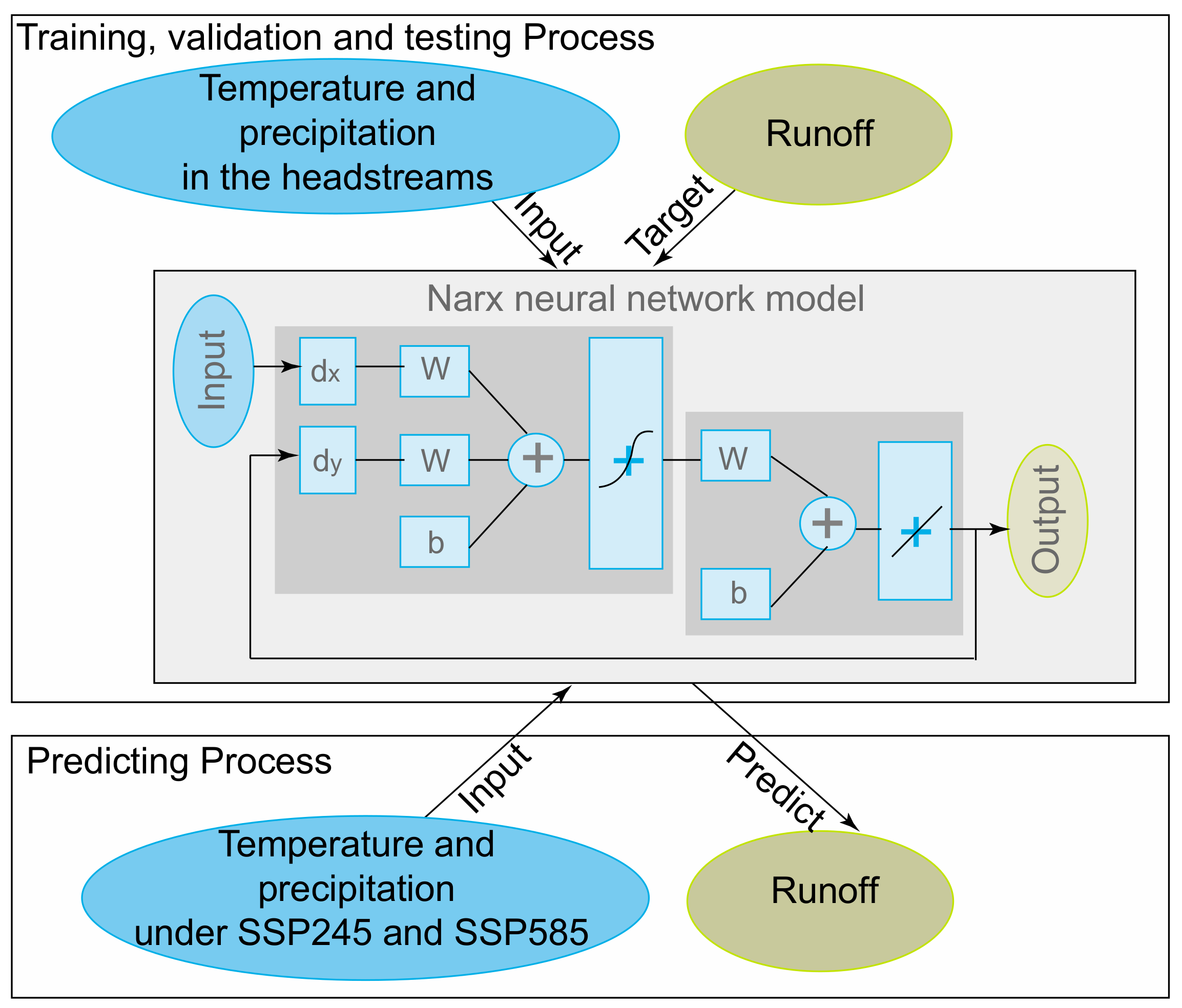

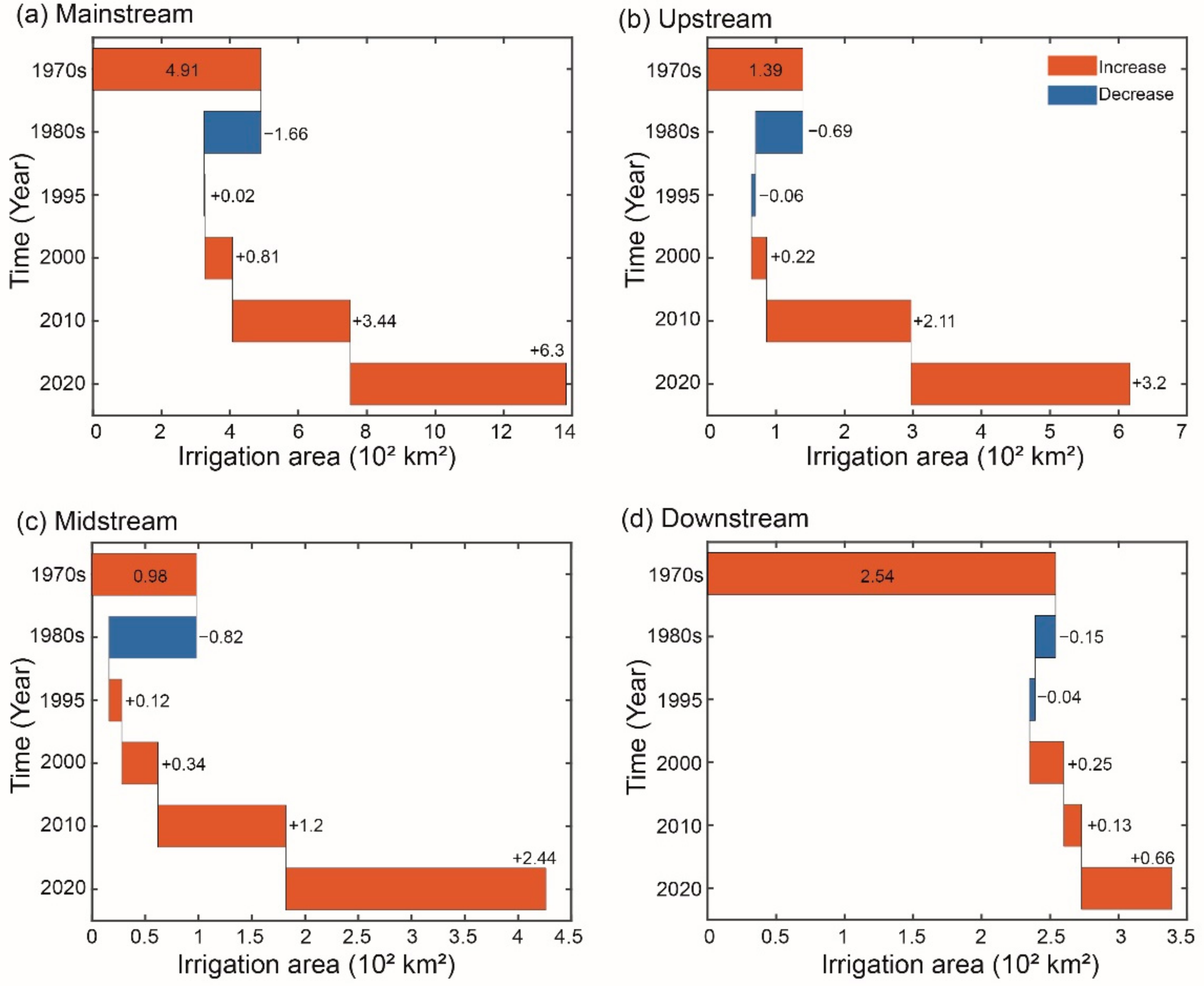

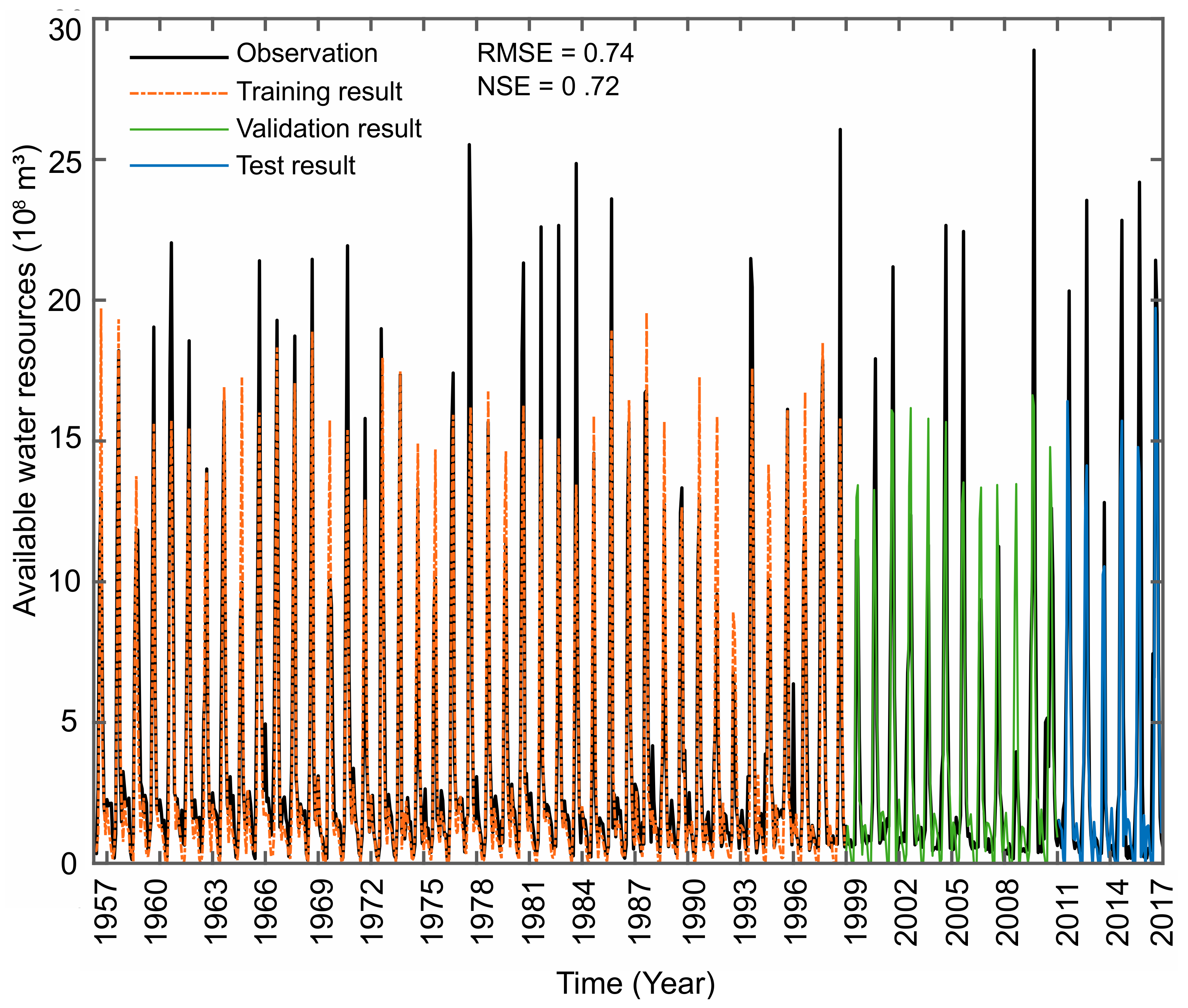

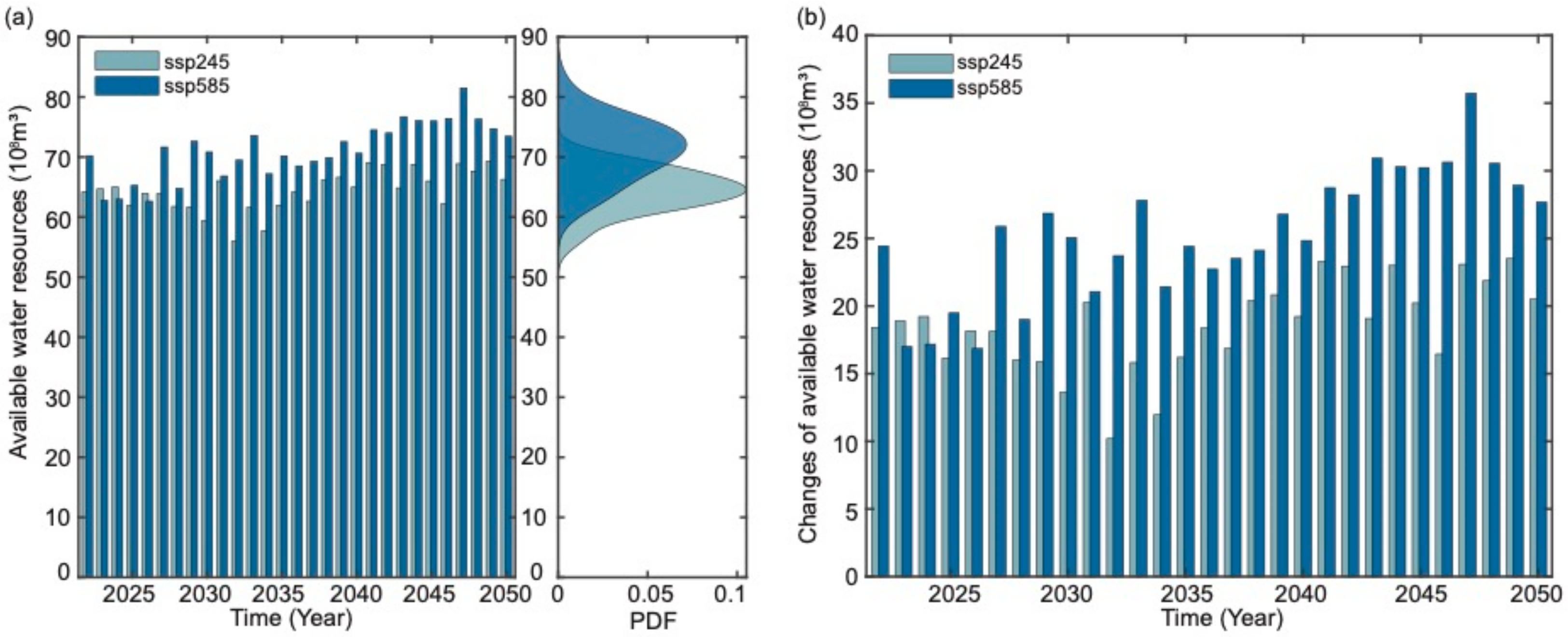

Publisher’s Note: MDPI stays neutral with regard to jurisdictional claims in published maps and institutional affiliations. |
© 2022 by the authors. Licensee MDPI, Basel, Switzerland. This article is an open access article distributed under the terms and conditions of the Creative Commons Attribution (CC BY) license (https://creativecommons.org/licenses/by/4.0/).
Share and Cite
Liu, Q.; Liu, Y.; Niu, J.; Gui, D.; Hu, B.X. Prediction of the Irrigation Area Carrying Capacity in the Tarim River Basin under Climate Change. Agriculture 2022, 12, 657. https://doi.org/10.3390/agriculture12050657
Liu Q, Liu Y, Niu J, Gui D, Hu BX. Prediction of the Irrigation Area Carrying Capacity in the Tarim River Basin under Climate Change. Agriculture. 2022; 12(5):657. https://doi.org/10.3390/agriculture12050657
Chicago/Turabian StyleLiu, Qi, Yi Liu, Jie Niu, Dongwei Gui, and Bill X. Hu. 2022. "Prediction of the Irrigation Area Carrying Capacity in the Tarim River Basin under Climate Change" Agriculture 12, no. 5: 657. https://doi.org/10.3390/agriculture12050657





